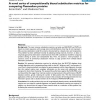Free Online Productivity Tools
i2Speak
i2Symbol
i2OCR
iTex2Img
iWeb2Print
iWeb2Shot
i2Type
iPdf2Split
iPdf2Merge
i2Bopomofo
i2Arabic
i2Style
i2Image
i2PDF
iLatex2Rtf
Sci2ools
BMCBI
2008
2008
A novel series of compositionally biased substitution matrices for comparing Plasmodium proteins
Background: The most common substitution matrices currently used (BLOSUM and PAM) are based on protein sequences with average amino acid distributions, thus they do not represent a fully accurate substitution model for proteins characterized by a biased amino acid composition. This problem has been addressed recently by adjusting existing matrices, however, to date, no empirical approach has been taken to build matrices which offer a substitution model for comparing proteins sharing an amino acid compositional bias. Here, we present a novel procedure to construct series of symmetrical substitution matrices to align proteins from similarly biased Plasmodium proteomes. Results: We generated substitution matrices by selecting from the BLOCKS database those multiple alignments with a compositional bias similar to that of P. falciparum and P. yoelii proteins. A novel 'fuzzy' clustering method was adopted to group sequences within these alignments, showing that this method retains...
| Added | 08 Dec 2010 |
| Updated | 08 Dec 2010 |
| Type | Journal |
| Year | 2008 |
| Where | BMCBI |
| Authors | Kevin Brick, Elisabetta Pizzi |
Comments (0)

